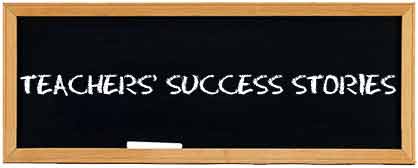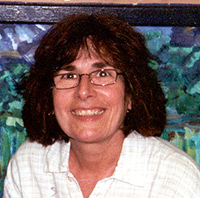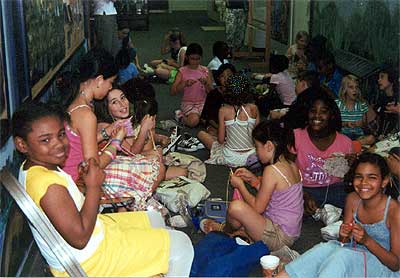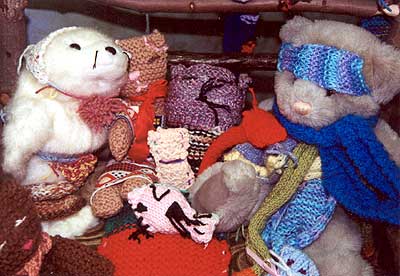

Judith Symonds, Special Projects Teacher Seth Boyden Elementary School - Maplewood, New Jersey
Warm Up America! first met Judith when a story about the Seth Boyden Knitters appeared in The New York Times in 2003, and we've had a close association ever since. Seth Boyden was the first grammar school group that we observed first hand and it was the enthusiasm of the students, which brought us back numerous times and ultimately resulted in the production of our first video. Entitled Knitting A Community Together, it captures the dynamics of the Seth Boyden knitters and the interactions with parents and Judith. We invite you to view the video. With Judith's guidance, the Foundation also organized its first children's programs with New York City's Parks & Recreation Department. Following is the Seth Boyden Knitters story.

Judith Symonds is a special projects instructor at Seth Boyden Elementary School in Maplewood, NJ. Looking for a way to engage students, she drew on her experience as an artist, designer, and knitter. When she started knitting in school, students approached with interest. They were curious and wanted to learn. She had found her program and lunchtime "hallway" knitting classes were started. The next year, Judith Symonds wrote a mini-grant to a local educational foundation to fund a program called Knitting Together a Community (KTC). "Community" was defined as the school community and the community at large. Parents came to the school in the evenings twice a month to teach or learn knitting. Some were trained to help students during the day. Additional funds came from individuals, awards, and fundraisers. Knitting helped create a stronger sense of a school community. As her lunchtime classes grew, she quickly identified students who caught on to knitting techniques quickly and could teach others. She created a Master Knitter level to the program. And to help her keep up with the kids' knitting activities, she devised a system of color-coding yarns to alert her to a student's level of knitting.
Her approach is outlined in more detail below. If she were sitting with you right now, she would share that this program developed over time. When she started, she had no idea that more than 200 of the grammar school's 500+ children would be clamoring to be a part of KTC. Because creating a community that kids want to be a part of is key to the success of any such program, that's where our outline starts. Go to Top
Creating the right atmosphere
In developing your program, think in terms of "creating a window of opportunity" for all of your students. You want an atmosphere in which there is a level playing field, and all children have an opportunity to excel in knitting or crocheting. Strive to achieve:
- a totally relaxed environment
- non-threatening atmosphere
Create a home for your sessions. Judith carved out the end of a seldom-used hallway, but any space could be fashioned into a meeting area. This should be a space where supplies can be stored. Even the storage supply cabinet or closet can add to the excitement of the program. In Symonds' program when students reach a Master Knitter level, they can go to the cabinet and select a yarn of their choice. The area should have a bulletin board on which yarn related items could be displayed. Symonds counsels: keep it newsy and fun. Consider knitting related stories that appear in the media, interesting samples of yarns, and student projects. Symonds also had access to a glass-enclosed cabinet near the entrance to the school in which she displayed student projects. Students were thrilled to see their work displayed and it also interested other students in the program. Especially for grammar school children, Symonds feels strongly that the floor is the best place for teaching. It's more intimate; chairs do not separate them. Most importantly, the kids are comfortable. Also, a teacher can move easily between students. Go to Top
Teaching Approach
Symonds gives the kids a goal when they start the program. She tells them honestly that learning the skills can be challenging and it will take work. Her aim for students is to encourage experimentation and ultimately independence. To nurture this attitude, she will sometimes not answer a child's question directly but suggest they ask another student who is working on a similar project. Other times she might say: "I don't know the answer. How do you think you could solve the problem?" She counsels not to teach knitting or crocheting to your own standards. Of course, she teaches students correct techniques, but there are often several ways to achieve an attractive result, which also make the young knitter/crocheter happy. This point is especially important to stress to other teachers or parents who might be assisting you. That said, there are times when the only solution is to "rip it," referring to unraveling your knitting or crocheting, and Symonds suggests talking to students about it as well. (If you are a knitter/crocheter, you are familiar with this term, which when repeated several times in succession sounds like a frog.) Symonds shared the "rip it" and frog story with her students, explaining that ripping out your work is sometimes necessary. The kids loved the story and now refer to ripping out as "Give it a FROG!" Go to Top
Discipline is essential to creating the right atmosphere
Students have to know when they enter this area that they must: Shelve acting out. You want a relaxed, non-threatening atmosphere, not a chaotic one. Symonds and other educators have commented about the calming effect that knitting and crocheting have on children. When calm prevails, a wonderful thing happens. Kids start listening and talking to one another. Out of this exchange grows understanding and respect.
Getting Started
To start, assume your students have no experience with knitting or crocheting. Judith gives beginning students needles on which three rows of ten stitches are already knitted or the equivalent in crochet. She recommends ten stitches, which are easy to count and keep track of. Judith and her students often sit on the floor close together so they can see what each one is doing. She teaches the continental, or European, method of knitting. Later students learn how to cast on, the purl stitch, and binding off. For crochet, they initially learn single crochet and how to create a foundation row and chaining. Go to Top
Supplies
Medium weight acrylic yarn (worsted weight—look for the #4 symbol on a yarn label) ![]()
5 or 5.5 mm or 8 or 9 short plastic knitting needle
5.5 -6 mm or I-9, J-10 plastic crochet hook Using a yarn winder, large skeins of yarn could be wound into smaller balls. Students only need 1 oz. yarn balls to start. Color-coding the yarn with student abilities is a great way to keep track of student progress. Judith starts students on white yarn until they learn to knit, purl, cast on, and bind off. Crochet students learn how to single crochet, make a chain stitch and a foundation row. Both groups must understand how to read a basic pattern. Master knitters/ crocheters work with pale colors and, eventually, fancy yarns and bamboo needles. They learn to increase, decrease, join, stuff, and they help teach other students. Students are responsible for their yarn projects between classes. Note about supplies: Some supplies may be donated for this worthwhile program. The most expensive supply was knitting needles that students kept losing. She tells students the first set or needles or hook are free. If they lose them, a replacement will cost $4. However, there are extenuating circumstances and teachers will have to use their judgment regarding charging for replacements. Go to Top
Incentives for kids
Students want to belong to a group. Creating an identifying item for the knitters, like a bag, a button, a backpack tag, unites the students.
Complement what children are learning in other classes
Judith tries to integrate the curriculum with knitting. When students work with microscopes in science, they look at magnified fibers, too. When students study plants, they grow, harvest, and boil leaves, roots, and petals for dying the wool. When students study colonial America, they spin, weave, and knit the way it was done. Students are sometimes allowed to knit when they finish their schoolwork, when recess is held indoors, or when they finish lunch. Go to Top
Selecting Projects
 Judith emphasizes the process, not the project. The pressure shouldn't be on the product; it will evolve. The process of learning and creating is what's important. When students are able to knit or crochet ten relatively even stitches, they usually start on what the Seth Boyden Knitters call a "humbug." A "humbug" is a 3-dimensional triangle made from two knitted or crocheted squares, which can be decorated in a variety of ways. Other popular early projects include scarves, cell phone covers, stuffed animals, and inventive clothing for stuffed animals. Projects might be based on current movie themes (e.g., creating fish, lobsters, and starfish from the movie, Finding Nemo), foods, or household objects — anything that makes you laugh, and doesn't use a lot of yarn. Symonds has a collection of Teddy Bears that she encourages students to dress. While the "clothing" the kids design might not be perfect fitting, the bears seem perfectly pleased with their caps, scarves and sweaters. Dressing Beanie Babies® is another favorite project for grammar school kids. Around the Christmas holidays, Symonds had the children create carrot shaped ornaments. The ideas are endless. Brainstorm with students, and you'll have more ideas than you need. Go to Top
Judith emphasizes the process, not the project. The pressure shouldn't be on the product; it will evolve. The process of learning and creating is what's important. When students are able to knit or crochet ten relatively even stitches, they usually start on what the Seth Boyden Knitters call a "humbug." A "humbug" is a 3-dimensional triangle made from two knitted or crocheted squares, which can be decorated in a variety of ways. Other popular early projects include scarves, cell phone covers, stuffed animals, and inventive clothing for stuffed animals. Projects might be based on current movie themes (e.g., creating fish, lobsters, and starfish from the movie, Finding Nemo), foods, or household objects — anything that makes you laugh, and doesn't use a lot of yarn. Symonds has a collection of Teddy Bears that she encourages students to dress. While the "clothing" the kids design might not be perfect fitting, the bears seem perfectly pleased with their caps, scarves and sweaters. Dressing Beanie Babies® is another favorite project for grammar school kids. Around the Christmas holidays, Symonds had the children create carrot shaped ornaments. The ideas are endless. Brainstorm with students, and you'll have more ideas than you need. Go to Top
